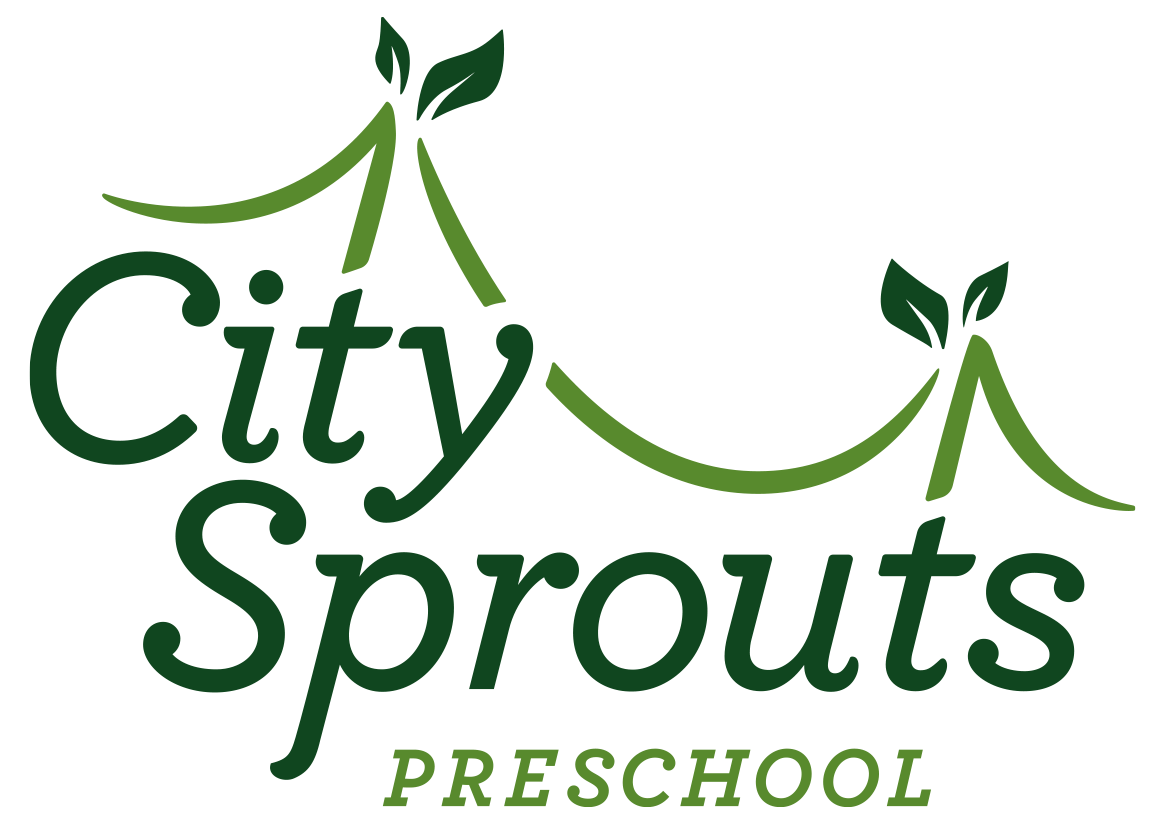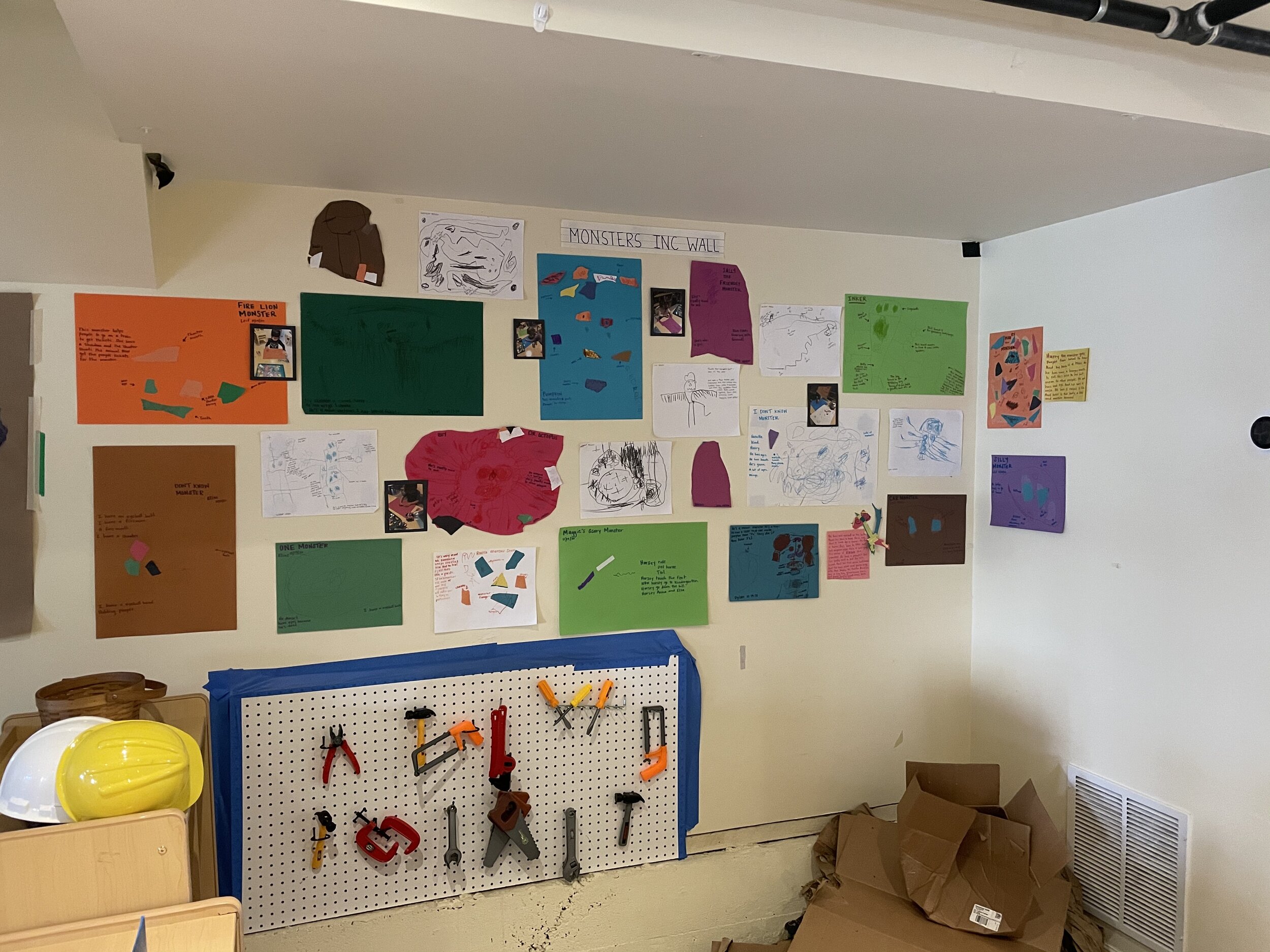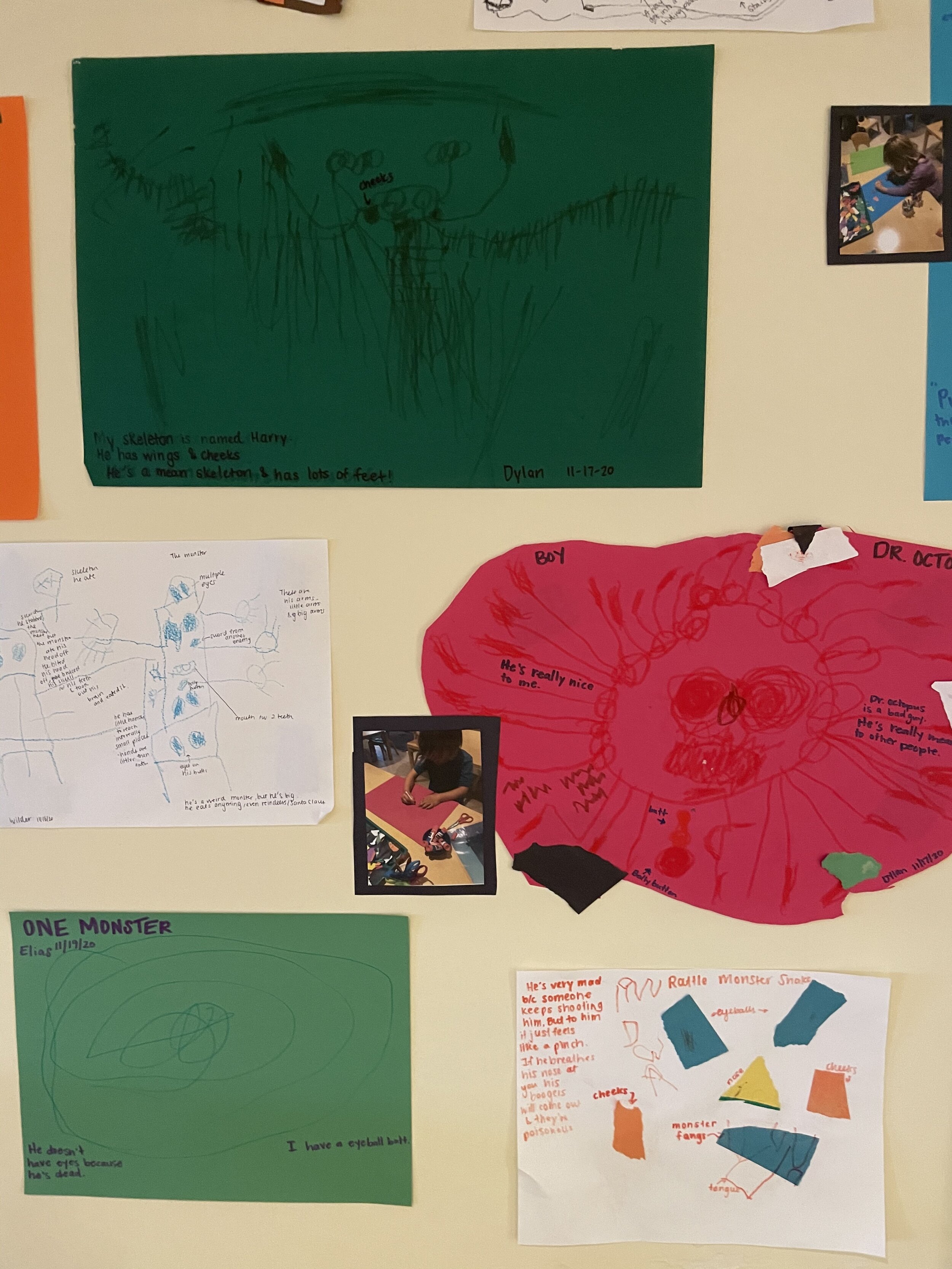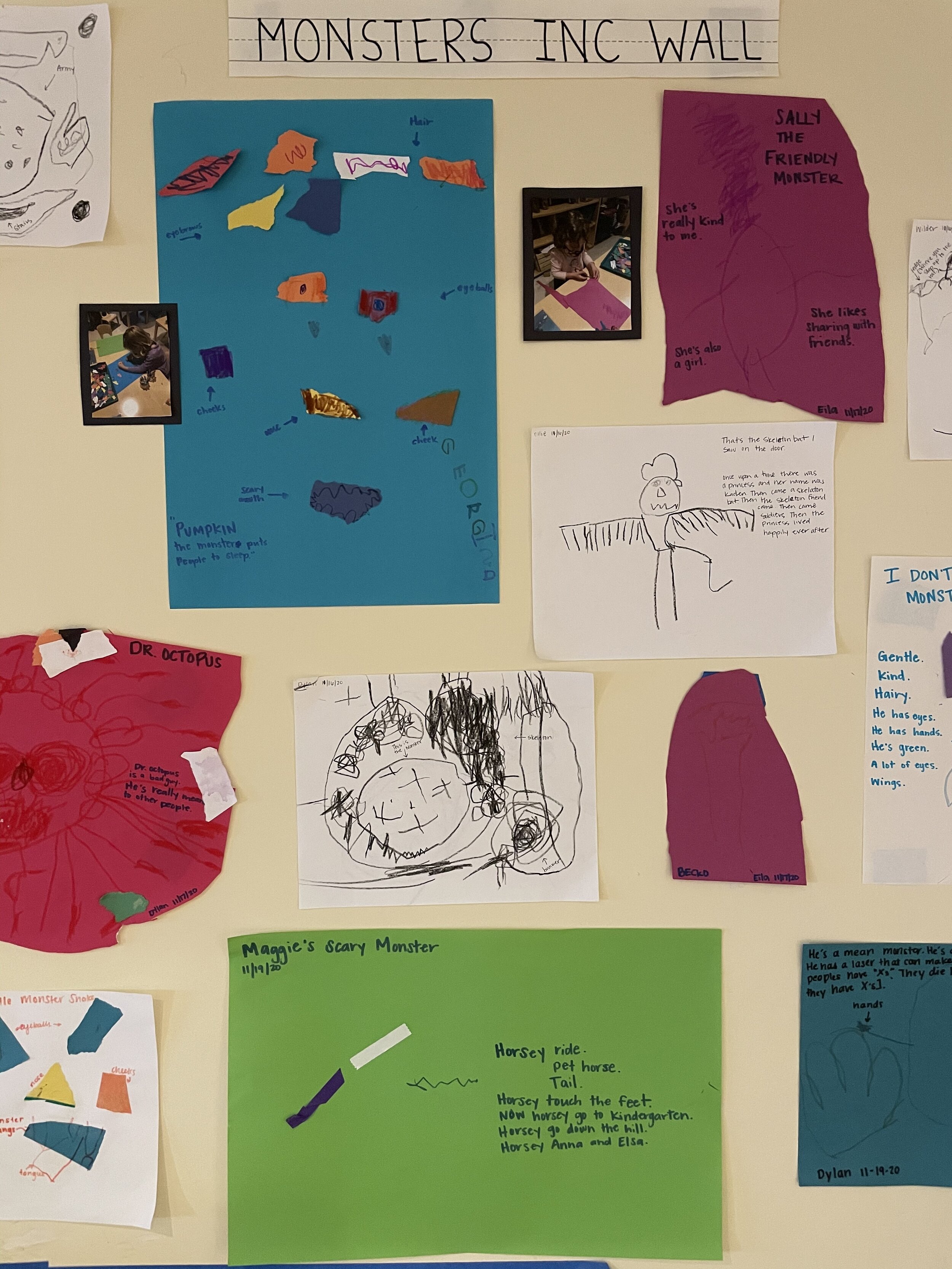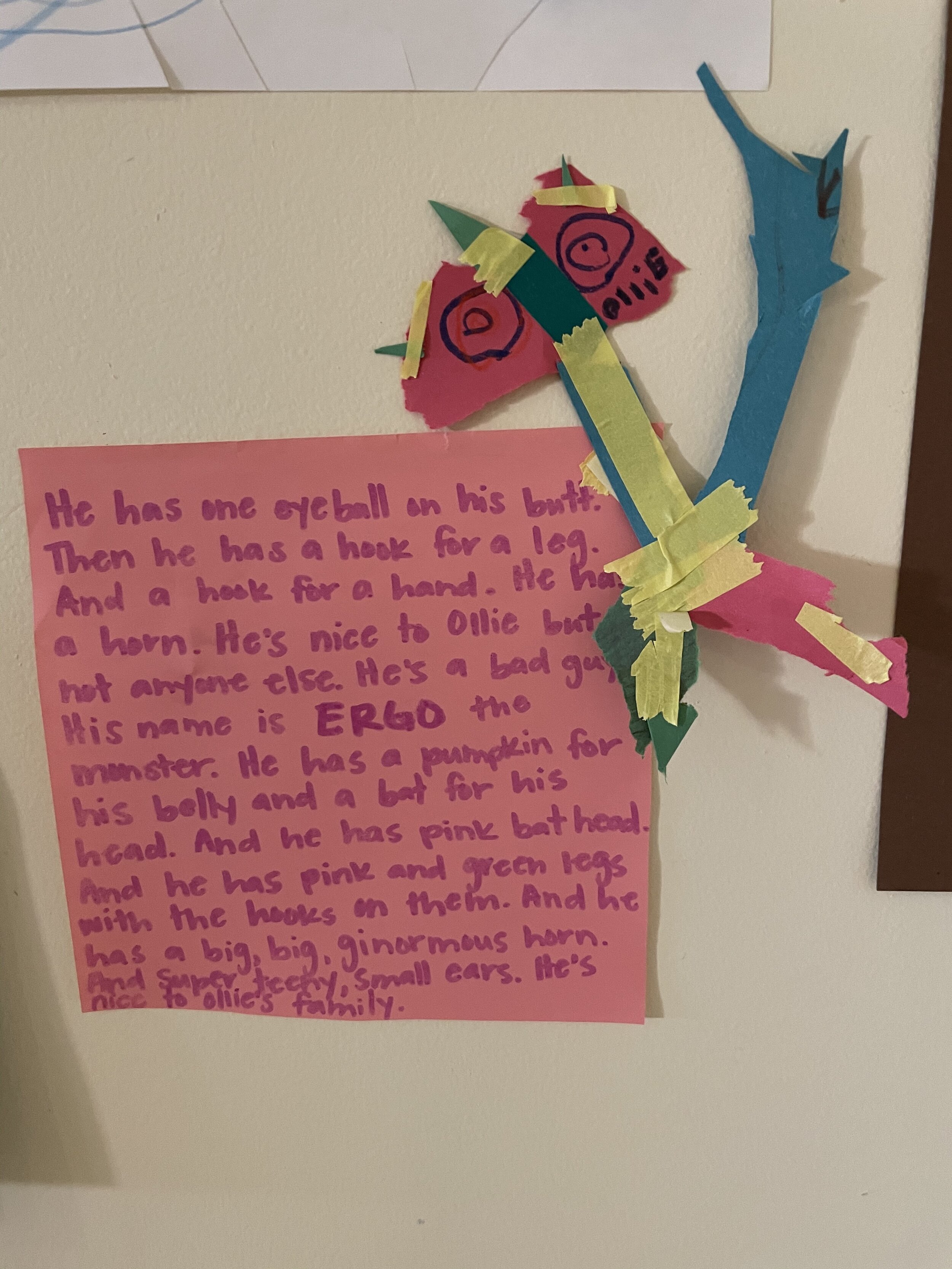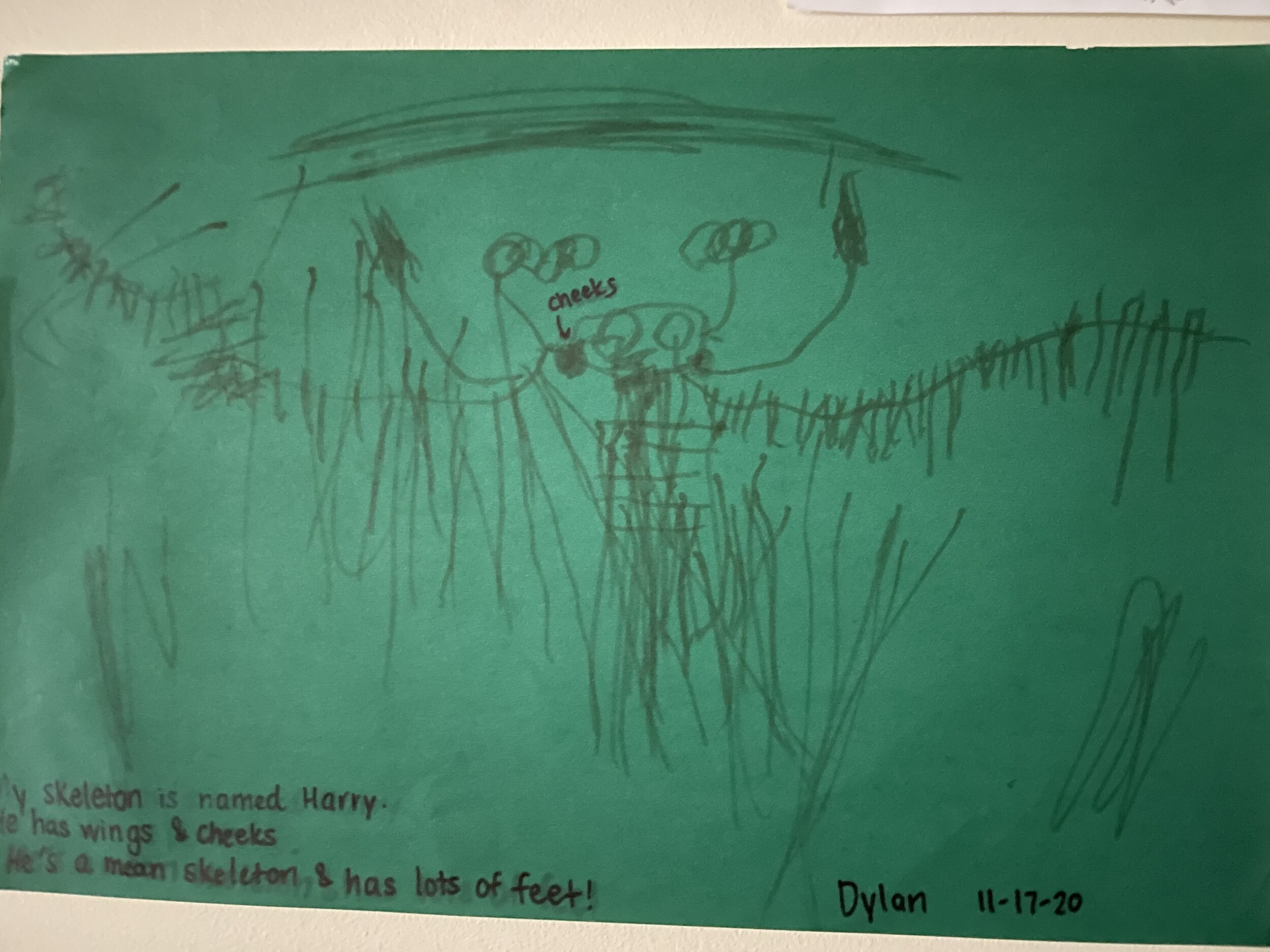On our way to Marin Headlands, the children discussed what they hoped to see or explore there:
Georgie - “I want to see pelicans.”
Wilder - “I wanna see coyote’s.”
Xavi - “I want to see coyote’s too.”
Eila - “I would like to see the leaves. I want to climb trees.”
Leif - “I wan to see, to see the footprints on the trail.”
Tadhg - “I’d like to climb trees and logs.”
Elias - “I want to see rollie-polleys.”
Frankie - “I want to look at ladybugs.”
Maggie - “I want to be a ladybug!”
Sage - “I want to explore the logs. I want to work on the logs with tools.”
Dylan - “I want to explore signs.”
Dominic - “I want to explore worms.”
When we first got to the headlands we took a moment to explore the trailhead signs to decide as a group where we wanted to hike.
During our reflections on our way home from Marin Headlands, the children got to talking about the pretend monsters that were inside the bunkers. Some friends were even debating whether there were monsters in the bunker at all. “I think there’s no monsters in there,” Elias said. But others were determined that there were monsters in there based on the drawings on the doors (skeleton-bat). Alice wanted to keep the conversation going so she could build off of their ideas later in the afternoon. She would ask questions like, “what does your monster look like? Does it have ears, a nose, a mouth?” This got them thinking a little bit more deeper about their monster ideas. I heard Dominic say, “Mine has big teeth and a big mouth so it can eat up all the teachers!”
Georgie - “I liked to climb the army.”
Leif - “The kites are flying in the air.”
Wilder - “I liked going up the stairs at the army place.”
Sage - “I liked exploring around. I had lots of fun here.”
Ollie - I liked going on that thing that looked like a palace. I pretended to be a Night Queen.”
Dylan - “I liked playing Star Wars with Ollie. I was Darth Vader and Ollie was a storm trooper.”
Elias - “I liked playing in the leaves.”
Leif - “I liked to see the monsters. He come to eat every body!”
Frankie - “I liked the trees.”
Maggie - “Rainbow”
Dominic - “I liked finding rocks.”
Elias - “I think there’s no monsters because we can’t open the door.”
Ollie - “I know the monsters were there because I saw the drawn monsters on the door.”
Eila - “I found a stick and I loved walking with the stick.”
Courtney has been working on some play story reflections with the children where they take a moment to reflect on their day by drawing pictures and telling a story about them. Once we got back to campus from our bunker adventure, the older kids, Georgina, Wilder, Ollie, and Dylan asked me if they could do play reflections! This tells me that they are enjoying the process of reflection and that it has become meaningful to them. We practice reflection as a way to enhance children’s confidence in speaking about their personal experiences. It also opens up the opportunity to work out a conflict with a friend that happened earlier that day, or a way to express emotions that children’ couldn’t really express in the moment of their play.
Ollie recalled many details about the monster theme when he drew his own version of the skeleton-bat. He even made up his own story about it (which I think he was telling me the story of the narrative that was going on in his head while he was playing at the bunkers). For example, during our verbal reflections, Ollie said, “I liked going on that thing that looked like a palace. I pretended to be a ‘Night Queen.’” and this was his play story:
“Once upon a time there was a princess and her name was Kaden. Then came a skeleton-bat. Then a skeleton-bat friend came. Then came soldiers. Then the princess lived happily ever after!”
Wilder created a blueprint of the side of the bunkers he was exploring. He described the ledge that he used to get up to the roof of the bunker and showed me all the hiding spots, trails, and stairs leading to the bunker. He even narrated what Dylan was doing in his hiding spot that he drew - “Dylan was playing the bad guy here (Darth Vader).”
Georgina drew a birds-eye view of the bunkers. She drew the stairs, hiding spots, the lookout, and the “army”, which is what she calls the bunker.
Dylan drew a birds-eye view of the bunkers and even drew his version of the monster on a pair of doors like how he saw it at the location.
Every day for the rest of the week, the children showed strong interest in monsters and what they look like. Following the children’s interests, we provided materials for children to create their own monsters and for them to tell stories about them. This idea exploded into a documentation wall that the children called the “Monsters Inc Wall”. Each and every day since the Marin Headlands adventure the children have been imagining different monsters and providing narratives about them. We are so bummed that you can’t come into the classroom to check it out yourselves, but we hope that this blog post provides as much of a heartwarming experience as it would be to see in person.
Here are some of the children’s monster creations along with their narratives:
Elias
“I Don’t Know Monster”
Gentle. Kind. Hairy. He has eyes. He has hands. He’s green. A lot of eyes. Wings.
Eila
“Sally the Friendly Monster”
She’s really kind to me. She’s also a girl. She likes sharing with friends.
Georgina
“Harry the Monster”
Harry the monster gets people from school to home and his back is a train. And he has hair, a hungry mouth to eat. He’s nice to me but mean to other people. He only has one eye and he has a nose. He has two noses, two cheeks, and here is the body, a forehead, and another forehead.
Wilder
“INKER”
Giant eyeball. Poisonous fangs. Belly where he finishes his food. He can run SO fast. His feet move fast. The big hand is for grabbing big things! It can hold a giraffe and ate it! Skeleton - The monster ate the skeleton with it’s poisonous fangs. He bited his neck. The skeleton got eaten by the monster and now it’s on his belly. This hand moves SO fast it can catch spiders. This hand is for grabbing ladybugs. Three eyeballs.
Maggie
Horsey ride. Pet Horse. Tail. Horsey touch the feet. Now horsey go to Kindergarten. Horsey go down the hill. Horsey, Anna, and Elsa.
Ollie
“ERGO the Monster”
He has one eyeball on his hutt. Then he has a hook for a leg. And a hook for a hand. He has a horn. He’s nice to Ollie but not anyone else. He’s a bad guy. His name is Ergo the Monster. He has a pumpkin for his belly and a bat for his head and he has pink bat head. And he has pink and green legs with the hooks on them. And he has a big, big, ginormous horn. And super teeny, small ears. He’s nice to Ollie’s family.
Dylan
“Harry the Skeleton”
My skeleton is named Harry, He has wings and cheeks. He’s a mean skeleton and has lots of feet!
Leif
“Fire Lion Monster”
This monster helps people to go on a train to get tickets, She sees a shadow and the shooter shoots the animal. Now get the people tickets for the monster. Shooter mouth, one eye, little shooter thing, teeth, and nose.
ANji play story reflections
These “play story reflections” come from a Chinese Early Childhood Education philosophy called Anji Play. Anji play is a well-known approach to early childhood where the curriculum is child-centered and driven, where true play and reflection is a huge part of the children’s day. The five principles of Anji Play are similar to what we value here at City Sprouts - Love, Risk, Joy, Engagement, and Reflection. A huge part of the teacher’s role for the Anji Play approach is teacher reflection, very similar to Reggio Emilia’s approach to documentation and reflection that we already do. Studying Anji Play in my MA courses has shown me different ways I can approach reflection both as a teacher and for my students.
Here is a link to a PowerPoint that a colleague at SFSU and I made for a final project this semester. We speak to what Anji Play is, the teacher’s role, and the right of the child to learn through play. If you would like to learn more about True Play and Anji Play, here are some resources that you can explore:
Anji Play: Transforming the Teacher-Student Relationship
There is a True Play Network that you are free to join if you would like to see more personal stories and examples from Anji Play experts around the world. There are many videos of the Founder of Anji Play herself, Ms. Cheng Xueqin. I believe anyone can join the network, as long as you provide a strong interest in the community of children learning through play and real-life experiences.
